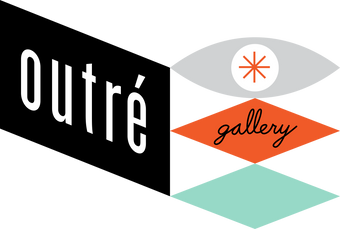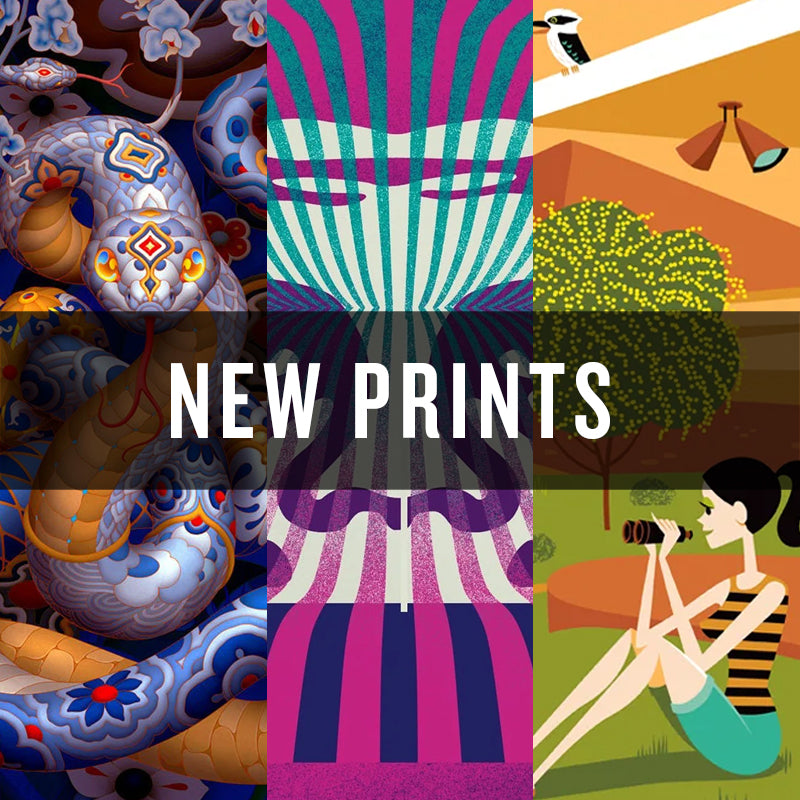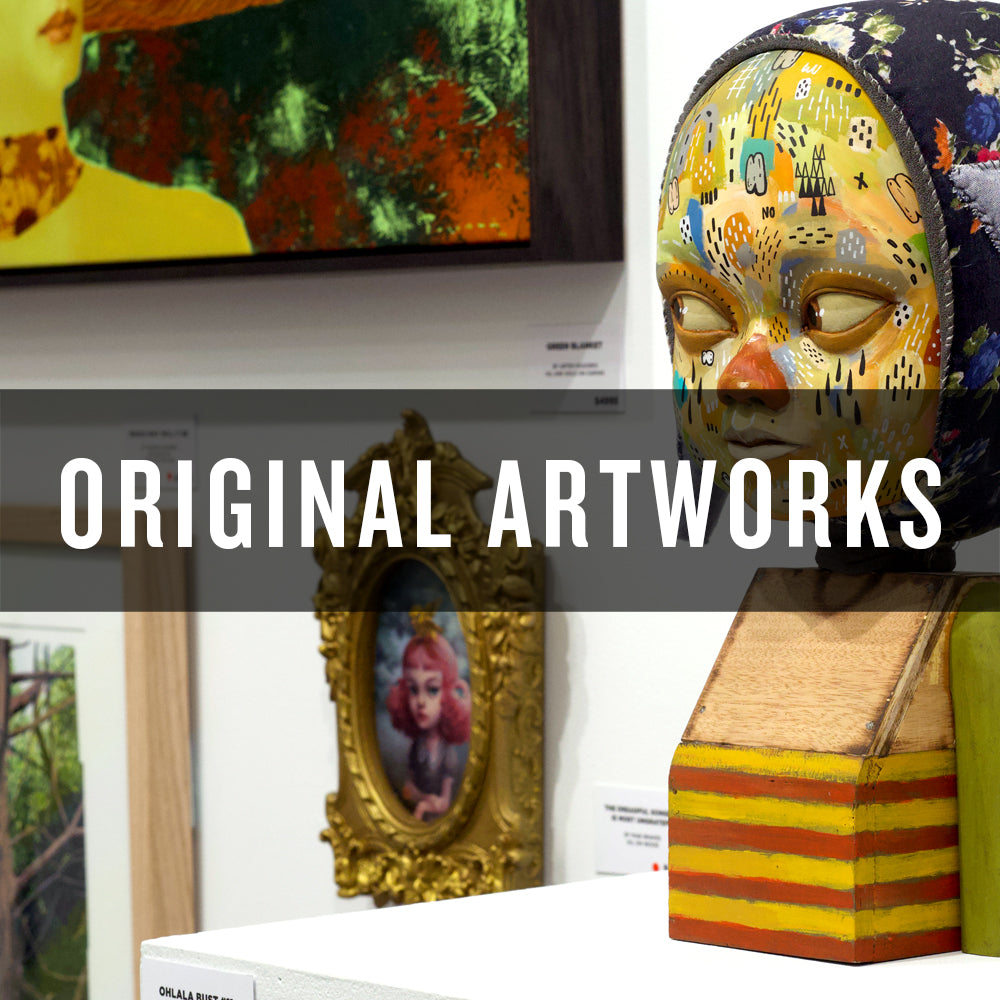
Louise Kyriakou is a Melbourne based artist whose current practice concentrates on the creation of contemporary ceramic forms using the traditional techniques of low relief sculpting and sgraffito decoration.
Originally an artist/illustrator accustomed to creating two-dimensional works, it wasn't until 2014 that Louise began experimenting with ceramics while teaching visual arts to secondary school students in East Gippsland. As she began exploring surface decoration techniques she could use for lessons with her students, Louise began creating faces on small clay plates with tribal inspired markings, and sunny expressions. The community of ceramic faces has continued to grow in number and style, and they now grace the walls of homes both in Australia and Internationally. Louise now divides her time between her art practice and her education roles in Secondary Schools in Melbourne.
In contrast to her mainly black and white ceramic work, Louise's painting is filled with bright colour and bold geometric compositions. Her interest in graphic design and Modern Art is evident in all her work, but making the work have her own distinct style, rather than an imitation of those before her, is an important aspect of her creation process.
Interview by Jessica Steger. Photos supplied by Louise Kyriakou.
In what ways did your childhood shape your pathway towards creating art? Do you come from a creative family?
My father is a very practical minded man with enough carpentry skills to fix the house and build a yacht, and my mother did lots of beautiful drawings and paintings as a young woman but didn’t continue to expand on her talents as she looked after four young children. In childhood, us kids pretty much took over every spare bench inside and outside the house with whatever projects we could think to create. I work like this even today. I think this environment of being allowed to make a mess and use whatever tools and materials we found meant we were free to express ourselves creatively and build confidence in that.
From the outset, my family was very supportive of my art. My siblings and I spent many hours on artistic endeavours like drawing, painting, sewing, making crafts, and even creating our own magazine, Toys Talent which folded after two issues. Our mum has kept a lot of what we made and there’s a treasure of comedy gold. As a kid I was the queen of colouring in between the lines and I had a few moments of artistic glory, winning colouring contests and getting my picture in the paper. It therefore it was no surprise that I’d keep going with it and somehow develop my talents into a viable career path.

Can you step us through your preliminary creative process? How do you get started on a body of work for an exhibition?
Unlike a lot of artists I don’t draw very often, and I don’t keep a journal of ideas. I really only draw when I need to and my style is to draw LOTS in a short period of time when I do feel the urge. I take advantage of the momentum when it strikes, and if good stuff starts to appear, this inspires me to keep going. Any seeds of ideas are kept for further development and refinement. When I know I have to create a body of work such as for an exhibition, sorting through these drawings and sifting out the ones that strike a chord with me get my mind excited to get started in planning and making.
For my paintings, I love using strong geometric forms, trying to capture a mix of simplicity and interesting structure, often chopping up and cropping initial ideas to get compositions to work. Once I have a fairly good outline of an idea on paper, I like to take the image into the computer and begin digitally redrawing the sketches in Illustrator. It’s the perfect tool for adjusting angles and trialling different colour combinations to resolve, before getting started on the actual painting.
As an artist who primarily creates painting and ceramic pieces, for this show I also wanted to have a new surprising element, and develop something sculptural. So many of the artists I am influenced by worked both in 2D and 3D forms and by looking into the way they transformed their work, I could see potential for the development of taking my flat work to new heights and forms. I’m really happy with the two sculptural pieces that did eventuate for this show.


How has your artistic voice developed over the last few years? Can you share with us a little about your journey towards your current art practice?
As someone who studied in illustration and design, my work has always had a foundation of representation and the use of strong, bold shapes and colours. When I began teaching art to secondary students my exposure to so many more artforms and artists’ work expanded rapidly, and therefore so did my ideas for my own art practice.
Teaching ceramics (when I hadn’t had much experience with it) was a pivotal moment in leading me to see how my illustrative characters could be utilised in a new artform. I wasn’t departing too far from my previous style, but I was swapping paper for clay. I had no idea this would open up opportunities to develop ceramic designs and eventually mean leaving teaching to have more time to devote to my work. I knew that I would miss all the visual stimulation and the buzz of working in art education, and so I now work part-time as an art technician at a school that has excellent facilities and great teaching staff. Everyday I’m surrounded by creative people and seeing students inspired to make all sorts of artforms, and it makes me want to go home and work on my own ideas.
The geometric style evident in my paintings also has its routes from my experience teaching. The first painting of this series was a grid-like documentation of what a week looks like when you find your life has become a block of timetables. My signature style therefore had a very structured foundation, but I’ve loved seeing it evolve and branch into new thematic territory. The use of people has been a constant, but I also am spending more time to be more playful to expand the way I express myself artistically. Really I’m just making things that I like, and I’ve found that a lot of people appreciate my aesthetic style.

We are excited to have you as part of our three artist line up at Outré Fitzroy! Please tell us about your idea behind the show Sunday Everyday and what people can expect to see?
As anyone who has been following my ceramic work for some time may know, I have begun using the sun as a central figure. Although the suns were a natural transition from the many other black and white face/mask designs I had been working on previously, I was initially creating them just because they gave me an opportunity to have more fun by playing with colour and pattern. The response I got from them was so positive, and people regularly relayed to me just how much they livened up their spaces when hung on their walls. It was only later that I began thinking more consciously about how the sun is a symbol of glory and brilliance, and that this too was something I was intent on sharing through my work. Who doesn’t enjoy in the happiness of the sun shining down on you?
Many years ago I had a mentor who had told me how personal symbols would appear in your work and only time would be able to tell you what those were. Well now that a number of years have passed I’m starting to see common threads running through my work and my life, and all things “sunny” seems to be one of them. (Even my first car was a Datsun Sunny which I was determined to get just because of the name!). The fact that my surname Kyriakou translates to Sunday, makes this even more fitting and personal.
My show includes seven suns, one for every day of the week. In this body of work I really wanted to indulge in the use of patterns and repetition, factors that are constant in day to day life, and keep it bright and positive. The paintings I’ve made for this show also touch on the idea of the cycles of life, and illustrate the routines we create in our everyday existence. I like the quiet life, and with Melbourne being in lockdown for a good chunk of time while I was making this work, the idea of being close to home and the element of being confined to the spaces we work and live in were ideas I wanted to communicate. The compositions of my paintings are of the everyday, quiet moments, staring into space, and going for a wander.

What would be a dream project to work on?
I don’t have a dream project as such. Everything I’ve created until now has been an organic process where one thing leads to another. I really just want to spend more time experimenting with new forms, material and techniques and have fun doing so. I think that comes through the work and keeps me excited to continue making.
What are some other upcoming creative projects that you're working on that we can keep a lookout for in the near future?
Hopefully I’ll have more figurative sculptures ready to show before the year’s out. There’s several designs in the works, but it’s also about getting the combination of form, material and finish to work in harmony. The few sculptural ideas I’ve shared have been really well received on Instagram so I’m keen to get more pieces happening on this front.
Thank you for chatting to us, Louise!
Sunday Everyday by Louise Kyriakou
Feature Show
Outré Gallery Fitzroy
31 July – 19 Aug 2020



